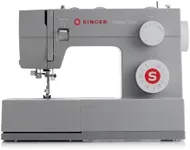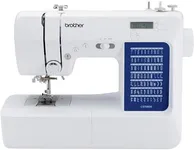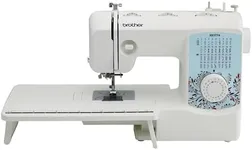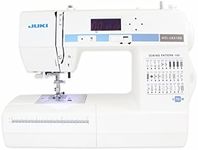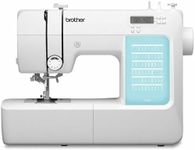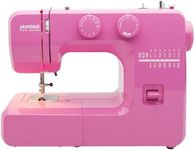Buying Guide for the Best Sewing Machines For Beginners
Choosing a sewing machine as a beginner can feel overwhelming, but focusing on your needs and understanding the key features will help you make a confident decision. Start by thinking about the types of projects you want to do, such as simple repairs, garment making, or crafts. Look for a machine that is easy to use, reliable, and not overloaded with complex features you may not need right away. Prioritize user-friendly controls and clear instructions, so you can learn and grow your skills comfortably.Stitch OptionsStitch options refer to the different types of stitches a sewing machine can make, such as straight, zigzag, and decorative stitches. For beginners, having a few basic stitches is usually enough to handle most projects. Machines with too many stitch options can be confusing and unnecessary at first. Look for a machine with essential stitches like straight, zigzag, and maybe a buttonhole stitch. As you gain experience, you can explore more advanced stitches, but starting simple helps you learn the basics without feeling overwhelmed.
Ease of UseEase of use covers how simple it is to operate the sewing machine, including threading the needle, winding the bobbin, and adjusting settings. For beginners, a machine with clear instructions, labeled dials, and automatic features like needle threading can make learning much smoother. If you’re new to sewing, choose a machine that is known for being beginner-friendly, with straightforward controls and helpful guides, so you can focus on building your skills rather than troubleshooting the machine.
Mechanical vs. ComputerizedSewing machines come in mechanical and computerized versions. Mechanical machines use manual dials and levers, while computerized machines have digital displays and buttons. Mechanical machines are often simpler and easier for beginners to understand, while computerized machines offer more features and automatic settings. If you prefer a straightforward, hands-on approach, a mechanical machine is a good choice. If you like the idea of push-button convenience and extra features, a basic computerized model can also be suitable, as long as it’s not too complex.
Speed ControlSpeed control allows you to adjust how fast the machine sews. This is important for beginners because sewing too quickly can lead to mistakes. Some machines have a foot pedal that controls speed, while others offer a speed slider or button. Look for a machine that lets you sew at a comfortable, slow pace as you learn. Being able to control the speed helps you practice accuracy and build confidence before moving on to faster sewing.
Built-in Needle ThreaderA built-in needle threader is a small feature that helps you thread the needle easily. This can save time and reduce frustration, especially if you have trouble seeing or handling small threads. For beginners, this feature is very helpful because it makes setting up the machine quicker and less stressful. If you want a smoother start to your sewing projects, look for a machine with a built-in needle threader.
Weight and PortabilityThe weight and portability of a sewing machine matter if you plan to move it around or store it when not in use. Lighter machines are easier to carry and store, making them ideal for beginners who may not have a dedicated sewing space. However, very lightweight machines can sometimes be less stable during use. Consider how often you’ll need to move your machine and choose one that balances portability with stability for your workspace.
Free ArmA free arm is a removable part of the sewing machine that makes it easier to sew small or circular items like sleeves and pant legs. For beginners, having a free arm is useful because it allows you to handle a wider variety of projects with less difficulty. If you plan to sew clothing or work on small items, make sure the machine has a free arm feature to give you more flexibility.

